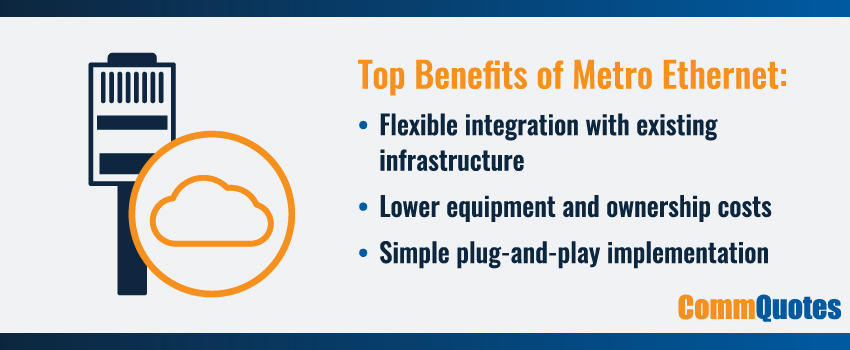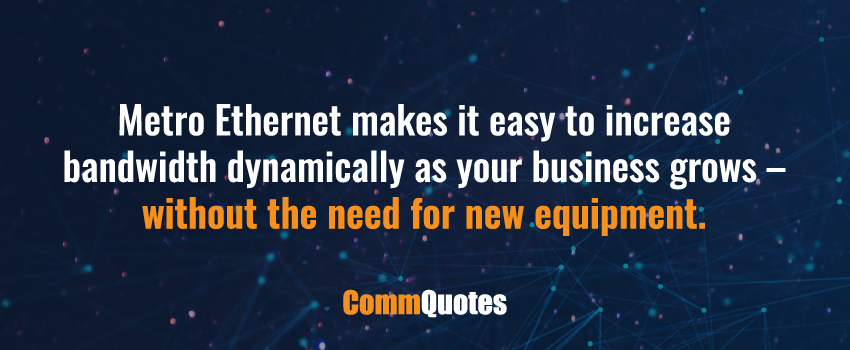As a business leader, you understand the importance of a reliable, high-speed internet connection. Unfortunately, traditional internet connections often struggle to meet modern businesses’ increasing bandwidth and security demands. That’s where metro Ethernet comes in, offering a flexible, high-performance, and scalable connectivity solution tailored to businesses operating within metropolitan areas.
The global metro Ethernet market is forecasted to reach $113.3 billion by 2031, growing at a CAGR of 10.7%.1 This growth is driven by the increase in adoption of cloud-based services, the need for higher bandwidth to support data-intensive applications, and the demand for seamless connectivity across multiple business locations.
In this blog, we’ll discuss what metro Ethernet is, its benefits, and how to find the right metro Ethernet provider to support your business’s connectivity needs.
What Is Metro Ethernet?
Metro Ethernet is a type of Ethernet transport network that provides point-to-point or multipoint connectivity services over a metropolitan area network (MAN). It’s designed to connect businesses, data centers, and other locations within a city or metropolitan area, enabling seamless communication and data transfer.
Businesses use metro Ethernet services to interconnect multiple sites or data centers, connect to the internet, access cloud applications, provide mobile backhaul services, and enable multicast delivery for applications like video conferencing and IPTV.

What Are the Benefits of a Metro Ethernet Network?
A metro Ethernet connection offers several benefits that make it an ideal internet option for businesses of all sizes. Here are some of the key advantages:
Flexibility
Metro Ethernet is highly flexible because it supports various services and transport technologies. This flexibility allows metro Ethernet to seamlessly integrate with your existing infrastructure and scale as your business requirements evolve.
Reliability
Metro Ethernet networks include Ethernet LAN service operations, administration, and maintenance (OAM) features that perform path discovery, detecting and reporting connection failures, and measuring performance metrics. These OAM capabilities provide a reliable connection by continuously monitoring the network and quickly identifying and resolving issues.
Cost-Effectiveness
A metro Ethernet network is significantly easier to maintain than traditional WAN networks like Frame Relay or ATM, translating to a low cost for equipment and ownership. The provisioning costs associated with metro Ethernet services are also lower than those of TDM networks, contributing to its cost-effectiveness.
Ease of Use
Ethernet is a widely adopted and familiar technology, so businesses can leverage their existing IT infrastructure and expertise to minimize the need for extensive training or specialized personnel. Metro Ethernet networks are plug-and-play, allowing for seamless integration with your current systems and facilitating a smooth transition. This ease of use reduces complexity and streamlines the implementation and management of your core network connectivity.
Quality of Service
A metro Ethernet network can support comprehensive QoS features like classification, marking, policing, queuing, and scheduling. These capabilities ensure that your critical applications receive the bandwidth and prioritization needed to prevent performance degradation due to low latency, network congestion, or competing traffic. Metro Ethernet’s QoS capabilities guarantee optimal performance for time-sensitive applications, such as voice and video conferencing, and prioritize mission-critical data transfers over longer distances.
Scalability
Metro Ethernet supports a wide range of speeds, from 1 Mbps to 10 Gbps, allowing you to increase your bandwidth dynamically as your business grows. This scalability is often achievable without installing new equipment, as metro Ethernet services can be provisioned on-demand and in granular increments. As your bandwidth requirements change, you can seamlessly scale your carrier Ethernet technology without disrupting operations or dealing with significant infrastructure upgrades.
Availability
Metro Ethernet services are widely available from major telecom companies, fostering competition in the market. This competitive landscape can lead to better pricing and more attractive offerings for business customers. With a range of service providers to choose from, you can select the one that best meets your requirements and budget. The high availability of Ethernet also ensures redundancy and reliability, as you can leverage multiple providers for added resilience.

What Are the Limitations of Metro Ethernet?
While metro Ethernet offers businesses several advantages, you should also be aware of its potential limitations and how to address them.
Some challenges businesses might encounter with metro Ethernet include:
Protection Mechanisms
Metro Ethernet traditionally had limited protection mechanisms for network disruptions, with slow failure recovery and a lack of fault isolation capabilities. However, solutions like IEEE 802.1s (Multiple Spanning Trees), IEEE 802.1w (Rapid Reconfiguration Spanning Tree), IEEE 802.3ad (Link Aggregation), IEEE 802.17 (Resilient Packet Ring), and MPLS now offer faster failover times and improved fault isolation.
In-Service OAM
Ethernet operations initially lacked the ability to monitor in-service bit-error rates (BER) and perform loop-back and reachability testing. Ethernet standards bodies like IEEE, MEF, and ITU-T address this limitation by specifying Ethernet link OAM and end-to-end in-service OAM for metro Ethernet solutions.
Scalability and Resource Utilization
The limited VLAN tag space and spanning tree issues in a traditional Ethernet tree service can restrict scalability and resource utilization in metro environments. Proprietary tag-stacking schemes and emerging standards aim to address these concerns.
Adopting an MPLS network allows businesses to leverage its advanced traffic engineering and QoS capabilities to overcome some of the limitations inherent in metro Ethernet networks. MPLS provides a scalable and flexible solution that can seamlessly integrate with metro Ethernet, enabling businesses to enjoy the benefits of both technologies while addressing their specific requirements for QoS, protection, and scalability.
Find the Right Metro Ethernet Provider With CommQuotes
Metro Ethernet offers a reliable, high-speed, and scalable connectivity solution that can help your business stay competitive in today’s digital landscape. But with so many options available on the market, choosing the right metro Ethernet service provider is crucial to ensure you get the most out of this technology.
If you’re struggling to find the right internet solution for your business networks, CommQuotes can help. Whether you need point-to-point or point-to-multipoint connectivity services to connect your business offices over a metropolitan area, our agnostic technology advisors can help you determine which Ethernet solution best sets you up for growth – at the best possible price.
Reach out to CommQuotes today to get started.
Sources:


